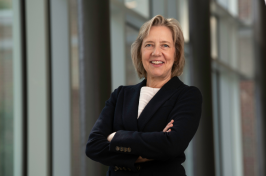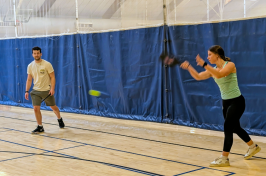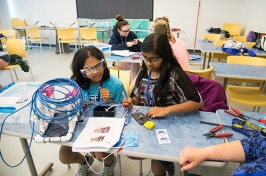
Natalie LaFlamme has taught sixth grade math for 27 years and for the first 20 years she had just one minority student. That’s all changed. Now the students in LaFlamme’s Nashua middle school classes come from all over the world, and they speak many languages. More than 50 languages are spoken by students in the Nashua School District, with Spanish second only to English. Students hail from 80 different countries, including the Dominican Republic, Brazil, India, Puerto Rico, Mexico, and Ukraine. In the last five years, the district has seen a 28 percent increase in students actively receiving English language learner (ELL) services.
Some are just learning to speak English. When the opportunity to participate in a UNH program known as GATE CITY to become certified as an ESOL teacher, tuition paid for, LaFlamme and two other teachers in her school promptly enrolled. They began the first course in January. Already, the course has prompted the veteran teacher to make significant changes in the way she teaches.
|
|
In the classroom
LaFlamme’s sixth-grade math class at Fairgrounds Middle School has a pleasant but brisk tempo. The students follow LaFlamme’s every move and intonation.
“Ok, let’s look at the bar graph. Don’t over think it. What is the average women’s shoe size for this store?”
By now a third of the class have their hands up. Still she waits.
Now the hands are waving. Finally, she lets someone answer.
Then she has the class graph the number of pets in their households by putting stickers on a poster board.
“No,” says LaFlamme to one student. “You can’t count your sister…” “What about my dad?”
LaFlamme gives him “the look” and everyone laughs. After all this is middle school.
Later she talks with another student and asks, “In Mexico do they teach long division differently?”
Immediately, several students correct her. “He’s from Honduras Mrs. LaFlamme!”
“Oh that’s right,” says LaFlamme, resuming the lesson without missing a beat.
LaFlamme has worked hard to create a classroom culture where her students don’t feel anxious about their ethnicities or their various levels of English fluency.
All around the room, posters and signs point to this goal. On the front white board is a list of English and Spanish mathematical terms, e.g., rate=tasa, ratio=proporción, and working together=trabajando juntos. High on the front wall of the classroom is an inspirational poster: “You cannot choose your circumstances, but you can choose to overcome them.” Prominently displayed as well are posters of the Common Core Standards and the expected grade-level competencies, which students will be tested on.
What is the GATE CITY program?
LaFlamme and her fellow teachers are part of the first 40-teacher cohort in the Nashua School district, kicking off what’s officially known as “GATE CITY: Getting All Teachers ESOL Certified in Two+ Years.” In January 2015, a second cohort of 40-teachers will begin, bringing the total to about 80 teachers who will have certification for English to Speakers of Other Languages (ESOL).
The program, a partnership between UNH and the Nashua School District, is funded by a $1.8 million National Development Grant from the U.S. Department of Education’s Office of English Language Acquisition. Its goal is to increase the academic achievement of English learners in the Nashua public schools, particularly in math and science.
Project director Judy Sharkey, associate professor and associate director of teacher education at UNH, has a good track record of providing ESOL training, having just completed a similar five-year project, focusing on English language learning that resulted in 40 ESOL-certified teachers in New Hampshire.
“The idea behind the GATE CITY program is to have more mainstream teachers be dual certified,” says Sharkey. “We want the person who’s expert in math, social studies, and history to also be able to work with English language learners.”
The program is also based on an adult learning model. Teachers in their schools comprise learning groups and as Wendy Perron, the project manager and lead instructor in the program explains: “This model honors the expertise of these veteran teachers. They can learn new teaching concepts and strategies to build on the good foundation they already have.”
New ways of teaching
During the course of her career, LaFlamme has successfully mastered No Child Left Behind, the Common Core Standards, and other curricula innovations. During her half-hour lunch break, LaFlamme reflects on what she’s learned.
“Before this year, I never knew that I should encourage communication in other languages,” says LaFlamme. “I don’t know why I didn’t know that. I was just—‘We’ve got to do English.’ I didn’t realize what a fallacy that is.”
What LaFlamme has learned is that her English language learners (ELL) pick up “conversational” English in about a year, but to learn “academic” English takes about five years. It’s the difference between talking in the halls and deciphering a mathematical word problem or between texting and writing a research paper.
In LaFlamme’s class, there is a lot of instruction that is conversational, so her ELL students follow along pretty well. And there are many effective teaching strategies to help ELL students with the academic English.
For example, other students who are bilingual can help out ELL students. Sometimes LaFlamme will give an ELL student class notes in Spanish and also translate tests into Spanish. What’s critical is that the ELL student continues to learn the subject matter and progress.
“I don’t worry about the kids learning English. They’re very social and will learn it, but my job is to teach them sixth-grade math,” says LaFlamme.
When LaFlamme describes the 77 sixth-grade students she teaches, it’s clear that she loves numbers. She notes that of that group probably 20 students are bilingual and fluent; they are not ELL students. Many speak more than two languages. There are students who speak Spanish, of course, but there are also those who speak Arabic, Nepali, Korean, Portuguese, Ukrainian, and African dialects. Students who are learning English participate in the ELL class. Some of those students have been at the school for a year, and others have just moved to the U.S. and speak little, if any, English.
“The course has helped me as a middle school teacher to affirm that knowing the kids and understanding their biographies is key,” says LaFlamme. “This helps me to create an environment where they are able to take risks and learn.”
This summer LaFlamme plans to take Spanish. Her students know this. And when LaFlamme or a student doesn’t know a word, the class jumps in to help. As LaFlamme says, “It’s not that we didn’t appreciate diversity before, we just didn’t celebrate it and now we do.”
LaFlamme acknowledges that incorporating these new teaching strategies can be tricky. “I have decades of curricula materials. I’ve already created my tests. And, I’ve had success,” says LaFlamme. “For a new teacher, adding this piece is challenging, but the goal is to help these students succeed.”
As GATE CITY project director Sharkey notes: “Affirming the students’ cultural, linguistic assets and increasing access to content expertise and experiences will open a range of career opportunities for our learners.”
Feeling at home
The Census Bureau projects that by the year 2030, school-age children whose first language is not English will comprise an estimated 40 percent of K-12 population in the U.S. Understanding how to work with English language learners (ELL) is critical.
And there’s another concern: the “U-curve.” Studies have shown that when students first come to the U.S., there’s often a honeymoon period. Many are excited to be in a new country. But other young students have arrived due to adverse circumstances. In any case, the challenge of adjusting to a new culture and language can result in a student’s becoming withdrawn and feeling a great sense of loss. This difficult and complex emotional phase is called, for efficiency’s sake, the “silent” period.
If a student can progress to learn conversational English and develop skills for learning academic English, the likelihood is that he will develop some humor about learning and soon feel at home. That student will probably graduate from high school. But many ELL students tend to drop out before high school.
In Veronica Bodden’s ELL classroom, a map of the world has pins identifying the many countries that individual students come from. As students filter into the classroom, Bodden, who is also enrolled in the GATE CITY program, talks to a parent on the phone in Spanish. The students chat and relax. This classroom is their home base at school, and Bodden, their teacher, is their emotional support.
Today in class they read a book about jellyfish. These ELL students love nonfiction, plus Bodden knows that they’ll love learning about a sea wasp whose sting can kill someone in three minutes. She’s not mistaken. Also, they love big dramatic words such as “predator,” “paralyze,” “tentacles,” and “poison.”
As they read and discuss the book, there is a stark contrast between their conversational chatter and their hesitant reading aloud. One student does not want to read aloud at all.
“Maria’s only been in this country for three weeks,” Bodden says. “So, I can understand her trepidation.”
Often Bodden asks, “What does this text mean? What are they saying? Connect the dots for me!”
One student who’s been in this class for about a year, engages immediately, responding in English and then quickly in Spanish. This learning process is additive rather than subtractive.
Later Bodden explains, “In Spanish, he just wants verification that he understands the English, and he does.
“Last year he entered the ‘silent period.’ He told me recently how hard it was for him. … He thought he’d never learn English.”
But today as he gathered up his books to head out to his next class, there was un aire de confianza y alegría en su paso (a sense of confidence and a spring in his step).
Originally published by:
The College Letter, Newletter for the College of Liberal Arts
-
Written By:
Staff writer | Communications and Public Affairs


















































